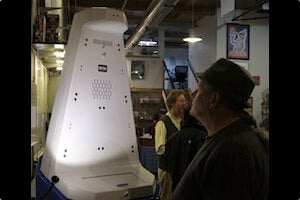
You know those movies where the thieves wait until the security guard falls asleep to break into the art gallery? Well, those days are over, now that the Vigilus robotic security guard has been launched.
The security robot from Vigilant Robots doesn’t get tired, doesn’t get bored, doesn’t constantly check Facebook while guarding a company’s assets. What Vigilus did do was perform so well it took home the ‘Security’s Best’ award at this year’s American Society for Industrial Security conference.
Looking more like an R2-D2 with cameras than Robo-Cop, Vigilus is designed to monitor areas normally patrolled by security guards – shopping malls, warehouses, event centers. But this isn’t a case of robots stealing our jobs, at least not yet. The robots will simply augment human security presence, allowing for greater coverage.
After being given a digital map of their location, Vigilus will patrol autonomously for up to ten hours, the life of its battery. It’s pretty good at getting around, moving easily over the thresholds and carpets commonly found in professional buildings. It responds to both voice and radio commands. Important sites in the area are specified by the client so that, in the case of an incident, the robot understands, “Go to the loading dock.” And as customer needs change often, the Vigilus’ maps can be changed easily and inexpensively. It’s monitored and controlled from a command console. From there, clients can track the robot’s location in real time, enter patrol commands and location vocabulary.

Its security capabilities are flexible as well. A suite of IP-ready devices provides clients with high-definition cameras, access control devices, different types of sensors including infrared, and other monitoring tools that a client would need. If it encounters an incident such as an intruder in a restricted area, it sends an alert over encrypted Wi-Fi so its human colleagues can mobilize to the scene.
Despite Vigilus’ warm reception at the ASIS, it’s hard to argue that the robot represents a groundbreaking idea. I mean, just strapping a camera to Roomba would already be a big step up in monitoring, say, at an art gallery. But if the idea of a roving security bot isn’t innovative, making it affordable is. In order to keep costs down – and clients interested – Vigilant Robots intentionally sourced almost all of their components from Colorado where the company is based. They don’t indicate the actual cost, but, according to the company, the end result is an extra patrol bot that costs less than a year’s salary for two security officers.
The company’s been working for the past two years to get it right, focusing their research on industrial security needs. Pam Gheysar, Vigilant’s CMO, said in a press release, “We had no doubt we could make a ‘cool’ robot,” she said in a press release. “That is relatively easy, but autonomy is hard.” The ASIS award was validation that the company had indeed created what was being called a “game’-changer.”
Art galleries around the world just got a little bit more secure.
[image credits: blastr and Vigilant Robots]
images: blastr and Vigilant Robots


